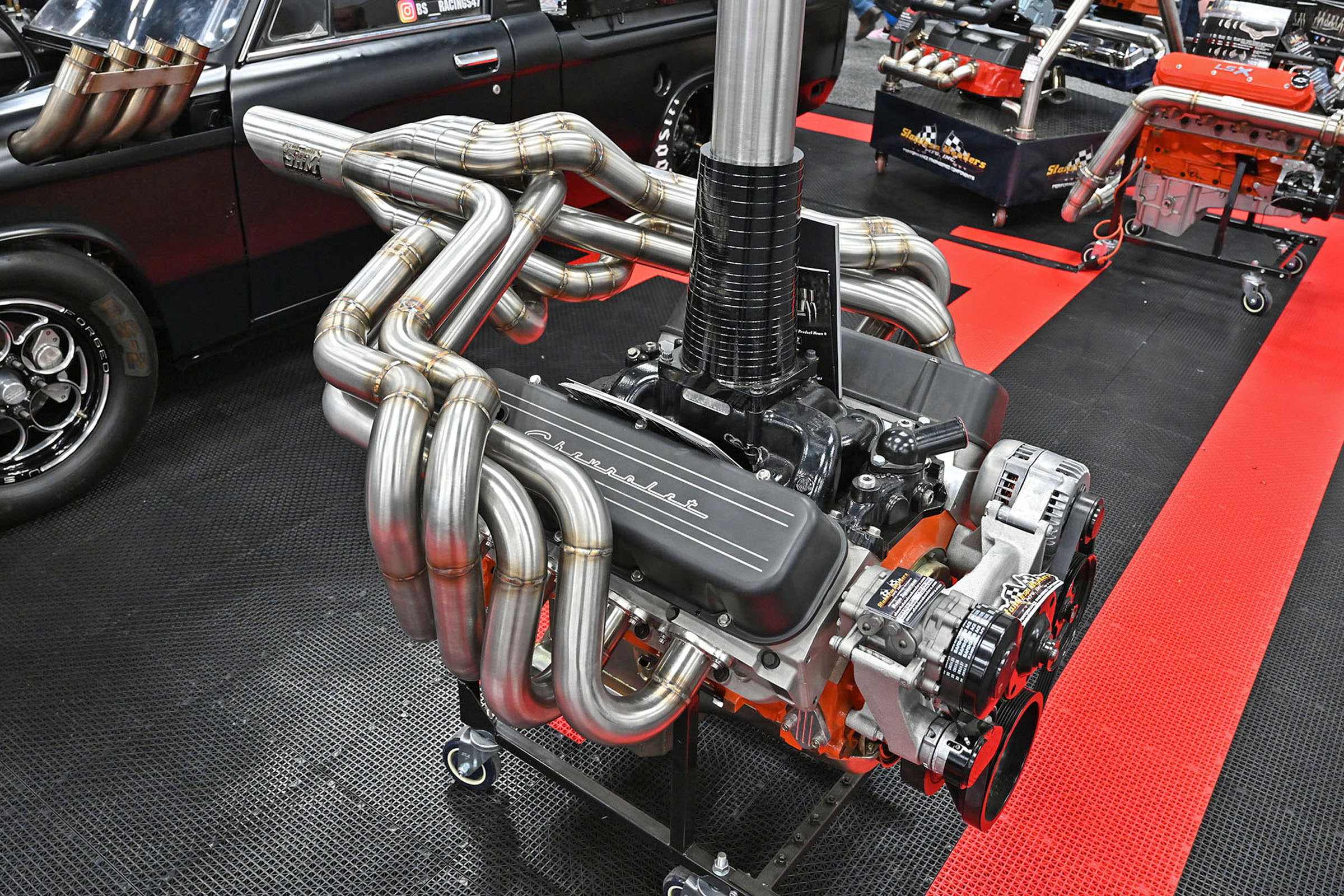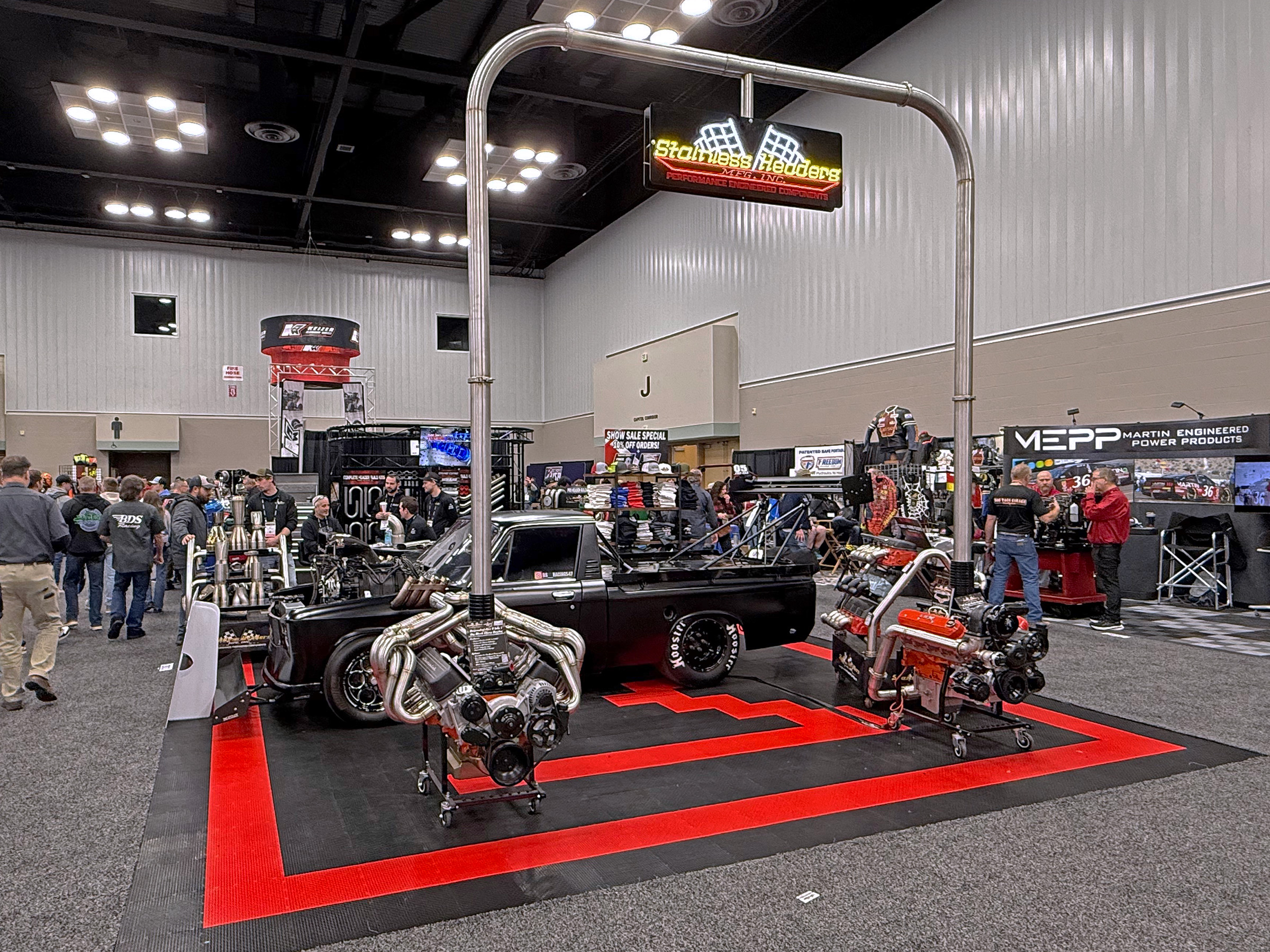...Or So We Thought
Oh man, this is like free horsepower! Pull the valve covers, swap the old rockers for these sweet, new 1.6:1 roller-tipped beauties, pop the valve covers back on and feel the power!”
Okay, we weren’t quite that naive about what we read regarding upgrading to 1.6 rockers on our small-block Chevy for the first time, but it was close.
The engine in question was a decent runner with 30,000 miles on the mild-performance rebuild. The rebuilt engine was purchased used, and among its selling points were 0.030-over 9.5:1 pistons, moly rings, 1.5 roller rockers, a Performer RPM intake and a brand-new Holley 750cfm carburetor. The cam wasn’t a perfect match to the torque converter used in the previous installation nor was the final-drive gear ratio. As a result, the owner planned on stepping down on the cam chart to a Comp 286H-10 cam, which came with the engine in its original box. Also included were a brand-new factory Z28 oil pan and a factory timing chain cover to replace the cheap chrome pieces. For $300, the engine package was a deal, and one we couldn’t pass up. We sold the aforementioned chrome pieces and matching valve covers for $50, getting us the engine at the bargain price of $250, and we still had the new cam and lifters on our shelf.
 In retrospect, we should have left the engine alone, but for the money, we couldn’t resist; we had budget left for an upgrade. The plan was to keep it simple, sticking to strictly bolt-on pieces that wouldn’t require taking the engine apart, and we drew the line at pulling the heads. Swapping the 1.5 roller rockers for a set of 1.6:1 full-roller rockers seemed like it filled our upgrade needs just perfectly. The upgrade would result in a little more performance from the existing cam (at least that’s what we read in the magazine, anyway). We weren’t expecting a huge increase in power, but the math will tell you there should be some difference. While it wouldn’t be huge, we liked the idea, because the quicker rocker arms open and close the valves faster without the rump-rump characteristics of a larger camshaft. This works great for street engines and is seemingly well worth the effort.
In retrospect, we should have left the engine alone, but for the money, we couldn’t resist; we had budget left for an upgrade. The plan was to keep it simple, sticking to strictly bolt-on pieces that wouldn’t require taking the engine apart, and we drew the line at pulling the heads. Swapping the 1.5 roller rockers for a set of 1.6:1 full-roller rockers seemed like it filled our upgrade needs just perfectly. The upgrade would result in a little more performance from the existing cam (at least that’s what we read in the magazine, anyway). We weren’t expecting a huge increase in power, but the math will tell you there should be some difference. While it wouldn’t be huge, we liked the idea, because the quicker rocker arms open and close the valves faster without the rump-rump characteristics of a larger camshaft. This works great for street engines and is seemingly well worth the effort.
Where we got sucker punched was taking every magazine article we’d ever read on the subject by its face value, believing that it was as easy as they made it out to be. Perhaps they were using all-new parts, but we had to deal with what we had: real-world parts.
An upgrade to roller-tipped 1.6:1 rockers can be a good investment—make no mistake about that—especially in the right application and for the time and money involved. But if you are like us and think this is a two-hour conversion on a Sunday afternoon, don’t kid yourself. It’s a far cry from simply removing the old and swapping in the new, faster ratio pieces, unless you are beginning with new late-model parts. All we really had to do was read the instruction sheets (a novel concept) that came with our Comp Magnum rollers to find this out. But even then, we figured we could “short cut” our way around some of the unexpected obstacles. We’re car guys! We know this stuff! And even though it took us a while, we finally thought better of it and did the job the right way. However, we did try everything we could think of to get it done some other way.

First up on our list of the unexpected was that the conversion requires guideplates. Did we order any? Nope. Well, you must have them, at least for the Magnum roller-tipped units (PN 1416-16) that we ordered (for use on older cast-iron heads with straight-across valve cover bolts, not the newer centerbolt valve covers). Our old 882 castings originally came with pressed-in rocker arm studs. Well, guess what? Guideplates require screw-in rocker arm studs to hold them in place.
So we did what anyone in our position would do and decided we could probably get away without running screw-in guideplates. Comp doesn’t recommend it, and the company’s tech guy was real clear about not recommending it when we called him on the phone. Well, we’re not real pro engine builders, and like many of you, we learn as we go, so we decided to skip the guideplates and move on to the next step. That decision didn’t get us very far, and we’re glad that we ran into other problems, which you will see.
The next item to be addressed was the interference between the pushrod and the pushrod hole. Early heads have a simple round hole that the pushrod passes through on its way to the rocker arm. However, 1.6 rockers have the pushrod seat moved closer to the trunnion area (the pivot area at the mounting stud), which changes the angle of the pushrod, making it sit between the top of the lifter and the rocker arm. Later heads have a larger hole, but our heads did not, and as you may expect, the pushrods contacted the head in a big way. Comp sells a slick little jig called a Louis tool that registers off the existing round hole in the head and allows you to create an oblong hole using a 5/16-inch drill bit in a hand-held drill. Great, but again you have the problem of metal shavings getting in bad places. For this one, we outdid ourselves by taping magnets and a pair of shop vacuums at each hole, plus we covered the lifter valley with masking tape and cardboard to guard against shavings falling down into the engine as we opened up the holes.
After getting the pushrods installed in their new, larger holes, we discovered another problem: coil bind. There was still some open space at the top of the coils, so they weren’t going to lock up completely, but we weren’t comfortable with what we saw. We called the tech guy again and told him what cam, rocker arms and heads we had and were told that with the correct springs, coil bind should not be an issue and that something else must be wrong. We broke out the measuring tools and checked total lift to verify what cam we had and then made an important call to the engine’s former owner. That’s when we found out that he had reused the stock springs during the rebuild. That was bad for us on so many levels.
Calling Comp with our new information, we ordered the proper springs and figured we might as well get the guideplates and studs and do it right. And while we were at it, another line in Comp’s instructions caught our attention:
Competition Cams strongly suggests when installing new rocker arms of any kind that new … pushrods be incorporated to ensure that all mating surfaces are fresh to prevent any premature failures. If you are using the old pushrods, examine the ends of each pushrod for any flaking or galling. Any imperfections on the ends of the pushrods will result in either rocker arm or lifter failure.
That makes complete and perfect sense to us, but to be honest, we figured that as long as all the pushrods were straight and not plugged, we could use them. We never read about replacing them, only about checking them, which was one of those common-sense checks. But pushrods are inexpensive, so better safe than sorry.

And since we were replacing the pushrods, we may as well check for the proper rocker arm geometry and get the correct-length pushrods. Roller tips make bad geometry less of an issue, but we couldn’t see the sense of upgrading rocker arms and not correcting something so simple. And the fix didn’t require additional engine teardown, just figuring out the right pushrod length and ordering them. So that’s what we did. Even with the wrong springs, the pushrod tip would be in the same location, so we reinstalled the rockers and used an adjustable pushrod to determine the proper length for the new set we needed. Clinging to the “quick and easy” myth, we had altered our plan a little bit but were still drawing the line at pulling the heads.
Plowing ahead with our misadventure up to this point, we turned our attention to the rocker studs. We once read a neat tip that you can remove pressed-in studs by stacking washers over the stud and drawing a nut down over it, and when the nut bottoms out on the washers, the stud will pull out of the head as you keep tightening. In fact, Power House Products has a tool that helps with this. It is a thick chunk of metal that takes the place of stacked washers with two holes in it, which slide over your two existing studs. Not only does it work for pulling studs, but you can also use it as a guide when tapping in the new threads for your screw-in studs. Now if you’re crafty, you can pull the stock pressed-in studs out of the heads, open up the holes with a bigger drill bit, and tap the heads for screw-in studs without removing the heads from the engine. We don’t recommend this because of the obvious chance of getting shavings down into places they shouldn’t go, but with several magnets placed around the hole and a strong shop vacuum sucking up chips as you go, it could probably be done. We proceeded just like any shade-tree mechanic.
It didn’t work—not for us, at least. We snapped off one of the studs (just the threaded end), but all hope was not lost. That’s when we called our local engine builder, who turned out to be a great guy, and asked him for some advice. That’s when he asked why our heads didn’t already have the work done when the cam was installed. We gave him more of the story and he kept getting hung up on why the screw-in studs weren’t installed when the spring seats were machined for the bigger springs.

That’s when the other shoe dropped. The cam required dual-valve springs, which required the spring seat to be machined. The tech guy hadn’t given us bad information; he had given us the information pertinent to the information fed to him. As it turns out, we were the problem, trying to get by without doing what really needed to be done and not realizing what we were working with in the first place. The tech guy just figured that with the cam we had in our engine, the dual-valve springs would have been installed already, and that is why he said that something else had to be wrong when we discussed the coil bind issue.
Even the extra, mildly smaller cam that came with the engine would require beefier valve springs, although they would be single springs and more marginal since we were running a manual trans. This eliminated the torque-converter mismatch the previous owner had, and we saw no reason to go with a milder cam, even a marginally milder one, which is what motivated us to install the 1.6:1 ratio rockers in the first place. Bigger springs, however, would require machining of the spring seats to accept the larger-diameter outer spring, and this would require pulling the heads.
While we were on the phone with tech support, finding out more about this situation, we learned that on a new engine with a stock cam, the stock springs can frequently be retained if the 1.6 rockers are the only change. Again, we cannot remember ever reading that stipulation in other magazine articles, but particulars are different with various head configurations, so I suppose it depends upon the parts involved. But even then, it’s a good idea to upgrade the springs. So that’s what we did. We sucked it up, pulled the heads and dropped them off at the machine shop.

Of course, it snowballed from there. Some of the valve tips were looking a little rough, and since we had to replace several of the valves anyway, we opened them up from the 1.94-/1.50-inch diameter to 2.02/1.60 inches. The machine shop was running a special, and the whole package was $400 out the door, including stainless valves. In the end, it all worked out for the better because our heads were vastly improved over the stockers, and the worn-out original springs were replaced with the correct dual springs.
Even though it all worked out in the end for what we thought would be a fun Sunday afternoon upgrade, there’s that little voice in the back of the head that says, You should have let well enough alone and not attempted to upgrade to 1.6 rockers. But that voice is wrong—dead wrong.
It wasn’t the fault of the rockers, and it certainly wasn’t the fault of the manufacturer; its instruction sheet was very clear. The previous owner deserves a good swift kick for reusing the old factory valve springs, but what do you expect for $300? And we deserve a swifter kick for not looking further into our swap than we did originally.
And this leads us to the point that our grandfather wouldn’t hesitate to point out. In the end, after finding out that it wasn’t going to go as we had planned, we would have saved ourselves a whole bunch of time if we’d just done it right when we discovered the problems, rather than trying to take all the short cuts. Perhaps on a stone-stock engine, the conversion to 1.6 rockers is a straightforward remove-and-replace ordeal, but that wasn’t our case. We’d still include them on a future engine build; the only difference is that when we do it next time, we’ll know what to expect. Follow along and you will, too.
















